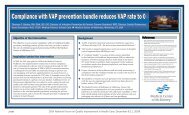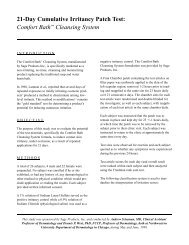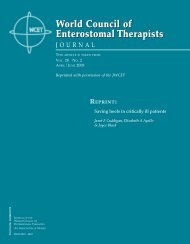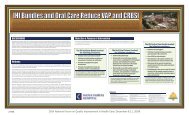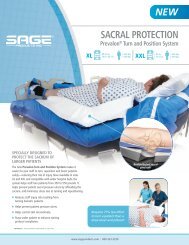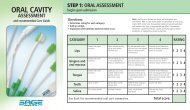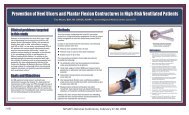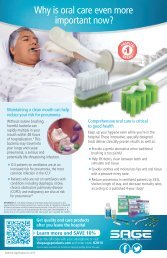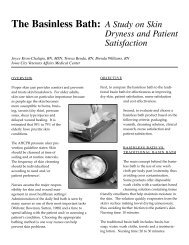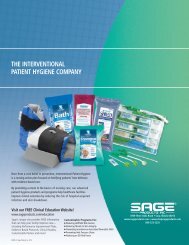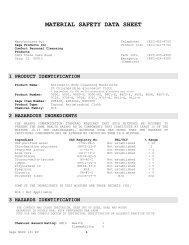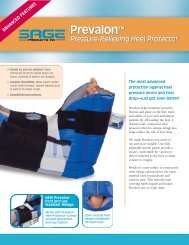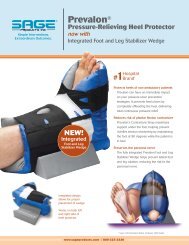Addressing JCAHO's patient safety goal #7 - Sage Products Inc.
Addressing JCAHO's patient safety goal #7 - Sage Products Inc.
Addressing JCAHO's patient safety goal #7 - Sage Products Inc.
Create successful ePaper yourself
Turn your PDF publications into a flip-book with our unique Google optimized e-Paper software.
<strong>Addressing</strong> JCAHO’s Patient Safety<br />
Goal <strong>#7</strong>:<br />
Focus on Key HICPAC Strategies for<br />
the Prevention of VAP<br />
Robert Garcia, BS, MMT(ASCP), CIC<br />
Brookdale University Medical<br />
Center, NY<br />
© 2004, R. Garcia The opinions set forth herein are those of the presentor and do not necessarily represent the opinions of <strong>Sage</strong> <strong>Products</strong>, <strong>Inc</strong>.
The Time for Implementing<br />
Measures to Prevent Ventilator-<br />
Associated Pneumonia is Now!
1. National Quality Issues<br />
Agency for Healthcare Research & Quality (AHRQ)<br />
• Issued review of 73 <strong>patient</strong> care practices;<br />
addressed VAP prevention<br />
Institute of Medicine’s (IOM) 1999 “To Err is<br />
Human: Building A Safer Health System”<br />
• Indicated that up to 98,000 Americans die<br />
each year as a result of medical errors<br />
The National Quality Forum<br />
• Safe Practices for Better Healthcare: A<br />
Consensus Report, May 2003. (national<br />
voluntary consensus standards, includes Safe<br />
Practice #19, “Prevent hospital-acquired<br />
acquired<br />
respiratory infections”)
2. Global Infection Control Issues<br />
Garcia R, Barnard B, Kennedy V. The fifth evolutionary era in infection control:<br />
Interventional Epidemiology. AJIC Am J Infection Cont, 2000;28:30-43.
“IE…is essential if the [IC] profession is to deal with<br />
the continued need to conserve resources, to lower<br />
costs, and to demonstrate improved clinical outcomes<br />
and satisfaction scores…it realizes that it is necessary<br />
for all projects, plans, activities, and ultimately all<br />
decisions stemming from an infection control program<br />
to be integrated with a business perspective”<br />
Garcia R, Barnard B, Kennedy V. The fifth evolutionary era in infection<br />
control: Interventional Epidemiology. AJIC 2000;28:30-43.
The Practice Arena of Interventional<br />
Epidemiologists<br />
Clinical<br />
Financial<br />
Customer<br />
Satisfaction
3. Regulatory Issues<br />
Joint Commission on Accreditation of<br />
Healthcare Organizations (JCAHO)<br />
• 2004 Standard:<br />
IC.1.10 “The organization uses a coordinated<br />
process to reduce the risks of nosocomial<br />
infections in <strong>patient</strong>s and health care workers …”<br />
www.jcaho.com/accredited+organizations/svnp/svnp_index.htm
Key 2004 JCAHO IC Focus<br />
Patient Safety Goal <strong>#7</strong>: Reduce the risk of<br />
health care-acquired acquired infections<br />
<br />
A change from emphasis on surveillance<br />
to one on intervention<br />
<br />
Effectiveness monitored by meaningful<br />
performance measures<br />
<br />
Core Measures: : Prevention of VAP<br />
Available at http://premierinc.com/all/<strong>safety</strong>/publications/12-03-downloads/06-IC-2005-<br />
standards.doc
JCAHO: PI & IC<br />
<br />
Improving Organization Performance<br />
• PI.1.10 – The hospital collects data to monitor its performance<br />
• PI.2.10 – Data are systematically aggregated and analyzed<br />
• PI.2.20 – Undesirable patterns or trends in performance are<br />
analyzed<br />
• PI.2.30 – Processes for identifying and managing sentinel<br />
events are defined and implemented<br />
• PI.3.10 – Information from data analysis is used to make<br />
changes that improve performance and <strong>patient</strong> <strong>safety</strong> and<br />
reduce the risk of sentinel events<br />
• PI.3.20 – An ongoing, proactive program for identifying and<br />
reducing unanticipated adverse events and <strong>safety</strong> risks to<br />
<strong>patient</strong>s is defined and implemented
JCAHO & PI<br />
“Performance measurement is used internally by health care<br />
organizations to support performance improvement and externally,<br />
to demonstrate accountability to the public and other interested<br />
stakeholders. Performance measurement benefits the health care<br />
organization by providing statistically valid, data-driven mechanisms<br />
that generate a continuous stream of performance information. This<br />
enables a health care organization to understand how well their<br />
organization is doing over time and have continuous access to<br />
objective data to support claims of quality. The organization can<br />
verify effectiveness of corrective actions; identify areas of excellence<br />
within the organization; and compare their performance with that of<br />
peer organizations using the same measures.”<br />
http://jcaho.org/pms/index.htm
High Risk, High Morbidity
VAP Facts<br />
Mechanical ventilation increases risk<br />
of pneumonia 6-216<br />
times (1% per<br />
day)<br />
Attributable mortality is 27% and<br />
increases to 43% when etiologic<br />
agent is P.aeruginosa or<br />
Acinetobacter sp.<br />
LOS with VAP is 34 days and 21 days<br />
without VAP
Cost of VAP<br />
Retrospective matched cohort study<br />
using data from large U.S. database<br />
9,080 <strong>patient</strong>s; 842 with VAP (9.3%)<br />
Patients with VAP had significantly<br />
longer duration of mechanical<br />
ventilation, ICU stay, and hospital stay.<br />
VAP associated with increase of<br />
>$40,000 in mean hospital charges<br />
Rello J, Ollendorf DA, Oster G, Vera-Llonch M, Bellm L, Redman R, Kollef MH.<br />
Epidemiology and outcomes of VAP in a large US database. Chest 2002;122:2115-2121.
Study Findings<br />
With VAP<br />
Without VAP<br />
Duration of Mechanical<br />
Ventilation<br />
14.3 ± 15.5 days 4.7 ± 7.0 days<br />
ICU Stay 11.7 ±11.0 days 5.6 ± 6.1 days<br />
Hospital Stay 25.5 ±22.8 days 14.0 ± 14.6 days<br />
Mean Hospital Charges $104,982 ± $91,080 $63,689 ± $75,030<br />
Rello J, Ollendorf DA, Oster G, Vera-Llonch M, Bellm L, Redman R, Kollef MH.<br />
Epidemiology and outcomes of VAP in a large US database. Chest 2002;122:2115-2121.
What strategies have been<br />
advocated in preventing VAP?<br />
<br />
<br />
<br />
<br />
<br />
<br />
<br />
<br />
<br />
Ventilator circuit replacement<br />
Heat and moisture exchanger replacement<br />
Closed suction catheter replacement<br />
Semirecumbent positioning of <strong>patient</strong>s<br />
Selective digestive decontamination<br />
Stress ulcer prophylaxis<br />
Enteral feeding methodologies<br />
Weaning<br />
Oral and dental care
HICPAC Guidelines on Preventing<br />
Pneumonia<br />
Issued 3/26/04<br />
<br />
Evidence-based<br />
<br />
Expert review<br />
<br />
Recommendations<br />
categorized<br />
www.cdc.gov/mmwr/preview/mmwrhtml/rr5303a1.htm
HICPAC Categories<br />
<br />
<br />
<br />
<br />
<br />
Category IA. Strongly recommended for implementation<br />
and strongly supported by well-designed experimental,<br />
clinical, or epidemiologic studies.<br />
Category IB. Strongly recommended for implementation<br />
and supported by certain clinical or epidemiologic studies<br />
and by strong theoretical rationale.<br />
Category IC. Required for implementation, as mandated<br />
by federal or state regulation or standard.<br />
Category II. Suggested for implementation and supported<br />
by suggestive clinical or epidemiologic studies or by strong<br />
theoretical rationale.<br />
No recommendation; unresolved issue. Practices for<br />
which insufficient evidence or no consensus exists about<br />
efficacy.
Ventilator Circuits<br />
<br />
<br />
Humidifier vs. HME technology<br />
HICPAC:<br />
Do not change routinely, on the basis of duration of<br />
use, the ventilator circuit (i.e., ventilator tubing and<br />
exhalation valve, and the attached humidifier) that is<br />
in use on an individual <strong>patient</strong>. Change the circuit<br />
when it is visibly soiled or mechanically<br />
malfunctioning. Cat IA [same as for HME - Cat II ].<br />
<br />
Kollef MH, Shapiro SD, Fraser VJ, et al.<br />
Mechanical ventilation with and without 7-day 7<br />
circuit changes: a randomized controlled trial.<br />
Ann Intern Med 1995; 123;168-74.
Heat & Moisture Exchangers (HME)<br />
<br />
<br />
Is filter hydroscopic or hydrophobic?<br />
HICPAC:<br />
No recommendation can be made for the preferential use<br />
of either HMEs or heated humidifiers to prevent<br />
pneumonia in <strong>patient</strong>s receiving mechanically assisted<br />
ventilation.. (Unresolved Issue).<br />
Change an HME that is in use on a <strong>patient</strong> when it<br />
malfunctions mechanically or becomes visibly soiled. Cat II<br />
Do not routinely change more frequently than every<br />
48hours an HME that is in use on a <strong>patient</strong>. Cat II<br />
Do not change routinely (in the absence of gross<br />
contamination or malfunction) the breathing circuit<br />
attached to an HME while it is in use on a <strong>patient</strong>. Cat. II<br />
<br />
Davis K, Evans SL, Campbell RS, Johannigman JA, Luchette<br />
FA, Porembka DT. Prolonged use of heat and moisture<br />
exchangers does not affect device efficiency or frequency rate<br />
of nosocomial pneumonia. Crit Care Med 2000;28:1412-18.<br />
18.
Closed Suction Catheters<br />
<br />
<br />
Manufacturers: replace at 24 hours<br />
HICPAC:<br />
No recommendation can be made about the<br />
frequency of routinely changing the in-line<br />
suction catheter of a closed-suction suction system in<br />
use on one <strong>patient</strong>. (Unresolved issue)<br />
<br />
Kollef MH, Prentice D, Shapiro SD, Fraser<br />
VJ, Silver P, Trovillion E, et al. Mechanical<br />
ventilation with or without daily changes<br />
of in-line suction catheters. Am J Resp Crit<br />
Care Med, 1997;156:466-72<br />
72
New Intervention: Redefining the<br />
Ventilator Circuit<br />
Ventilator circuitry was defined by three separate<br />
devices: tubing, HME, in-line suction catheter<br />
Revised policy to consider circuitry as single<br />
closed system; change when soiled, malfunction,<br />
<strong>patient</strong> transport<br />
Rates: 28.7/1000 VD in 2000; 9.8 in 2001<br />
Saved >$15,000 per year<br />
• Bertrand M, Zink K, McCormick J, et al. Reducing<br />
ventilator associated pneumonia by redefining the<br />
ventilator circuit as a single closed unit and eliminating<br />
routine component changes. [abstract] 2002 APIC<br />
Education Conference, Nashville, TN
Semirecumbent Positioning<br />
<br />
HICPAC:<br />
In the absence of medical contraindication(s),<br />
elevate at an angle of 30-45° the head of the bed of<br />
a <strong>patient</strong> at high risk for aspiration (e.g., a person<br />
receiving mechanically assisted ventilation and/or<br />
who has an enteral tube in place) Cat II<br />
<br />
Drakulovic MB, Torres A, Bauer TT, Nicholas<br />
JM, Nogue S, Ferrer M. A Supine body position<br />
as a risk factor for nosocomial pneumonia in<br />
mechanically ventilated <strong>patient</strong>s: a<br />
randomized trial. Lancet 1999;354:1851-58.<br />
58.
How high is 30 degrees?
Head of Bed<br />
<br />
How high is 30 degrees???<br />
• A lot higher then you might think<br />
• Look at objective gauges or LCD<br />
readouts
Can’t make it to 30 degrees?<br />
<br />
<br />
Situations when HOB up 30 degrees may<br />
not be possible<br />
• Low BP/unstable VS<br />
• Agitated and at risk of falling out of bed<br />
• Compromised circulation due to femoral<br />
lines<br />
• Spinal clearance/Spinal cord injury <strong>patient</strong>s<br />
– MUST have a physician’s order identifying<br />
the degree of elevation allowed<br />
Use combination of HOB up and reverse<br />
Trendelenburg to obtain a 30 degree<br />
angle
Stress Ulcer Prophylaxis<br />
<br />
<br />
Theory has it that modifying stomach acid<br />
effects the bacterial colonization level<br />
HICPAC:<br />
No recommendation can be made for the<br />
preferential use of sucralfate, H2-antagonists,<br />
and/or antacids for stress-bleeding prophylaxis<br />
in <strong>patient</strong>s receiving mechanically assisted<br />
ventilation. (Unresolved Issue)<br />
• Livingston DH. Prevention of ventilator-associated<br />
associated<br />
pneumonia. Am J Surg 2000;179(suppl 2A):12S-17S:<br />
17S:<br />
“after all of this time and study, it is likely that<br />
neither drug has any advantage in significantly<br />
maintaining gastric flora and reducing VAP.”
Selective Digestive Decontamination<br />
<br />
<br />
<br />
Preventive decolonization on the theory that the<br />
gut is a major source of VAP<br />
HICPAC:<br />
No recommendation can be made for the routine<br />
selective decontamination of the digestive tract (SDD) of<br />
all critically-ill, ill, mechanically ventilated, or ICU <strong>patient</strong>s.<br />
(Unresolved issue)<br />
30+ studies to date<br />
• Eggimann P, Pittet D. Infection control in the ICU. Chest<br />
2001;120:2059-2093:<br />
2093:<br />
<br />
“…this selective pressure on the epidemiology of<br />
resistance definitely precludes the systematic use of SDD<br />
for critically ill <strong>patient</strong>s”
Weaning<br />
Duration, duration, duration!!!<br />
<br />
<br />
Cook D, Meade M, Guyatt G, Griffith L, Booker L. Criteria for<br />
Weaning from Mechanical Ventilation. Evidence Report/Technology<br />
Assessment No. 23 (Prepared by McMaster University under<br />
Contract No. 290-97<br />
97-0017). AHRQ Publication No. 01-E010.<br />
Rockville MD: Agency for Health Care Research and Quality.<br />
November 2002.<br />
Evidence-Based Guidelines for Weaning and Discontinuing<br />
Ventilatory Support. A Collective Task Force comprised of<br />
members of the American College of Chest Physicians, the<br />
American Association for Respiratory Care and the American<br />
College of Critical care Medicine. Chest 2001;120:375S-395S.<br />
395S.
Prevention or Modulation of<br />
Oropharyngeal Colonization<br />
HICPAC:<br />
Oropharyngeal cleaning and decontamination with an<br />
antiseptic agent: develop and implement a<br />
comprehensive oral-hygiene program (that might<br />
include the use of an antiseptic agent) for <strong>patient</strong>s in<br />
acute-care care settings or residents in long-term<br />
term-care<br />
facilities who are at high risk for health-care<br />
care-associated<br />
associated<br />
pneumonia. Cat. II<br />
<br />
<br />
Schleder B, Stott K, Lloyd RC. The effect of a<br />
comprehensive oral care protocol on <strong>patient</strong>s at risk for<br />
ventilator-associated associated pneumonia. J Advocate Health<br />
2002;4:27-30.<br />
Yoneyama T, Yoshida M, Ohrui T, et al. Oral care reduces<br />
pneumonia in older <strong>patient</strong>s in nursing homes. J Am Geriatr<br />
Soc 2002;50:430-3.<br />
3.
Is there evidence that<br />
supports the<br />
implementation of a<br />
comprehensive Oral and<br />
Dental Care Program?
1. Oral Cavity vs. Gastric Colonization I<br />
<br />
Research over 20 years on influence of<br />
stomach and oropharyngeal colonization<br />
on respiratory infection<br />
• Garrouste-Orgeas M, Chevret S, Arlet G, Marie O, Rouveau M,<br />
Popoff N, Sclemmer B. Oropharyngeal or gastric colonization<br />
and nosocomial pneumonia in adult intensive care unit<br />
<strong>patient</strong>s. A prospective study based on genomic DNA analysis.<br />
Am J Respir Crit Care Med 1997;156:164<br />
• Bonten MJM, Gaillard GA, Van Tiel H, Smeets GGW, Van Der<br />
Geest S, Stobberingh EE. The stomach is not a source for<br />
colonization of the upper respiratory tract and pneumonia in<br />
ICU <strong>patient</strong>s. Chest 1994;105:878-84.<br />
84.
2. Oral Cavity vs. Gastric Colonization II<br />
<br />
“…decolonization approaches in the prevention of<br />
nosocomial pneumonia strongly suggests that<br />
oropharyngeal decontamination, indeed,<br />
represents the effective part of SDD [selective<br />
digestive decontamination], and that the majority<br />
of antibiotic use in SDD is unlikely to add<br />
beneficial effects”<br />
• Bergmans DCJJ, Bonten MJM, Gaillard CA, Paling JC, van<br />
der Geest S, van Tiel F, Besens AJ, et al. Prevention of<br />
ventilator-associated associated pneumonia by oral<br />
decontamination. A prospective, randomized, double-<br />
blind, placebo-controlled controlled study. Am J Resp Crit Care Med<br />
2001;164:382-88.<br />
88.
3. Link Between Oral Pathogens &<br />
Respiratory Infection<br />
<br />
<br />
<br />
A review article<br />
6 articles cited as<br />
support for a<br />
relationship between<br />
poor oral health and<br />
respiratory infection<br />
Bacteria from<br />
colonized dental<br />
plaque may be<br />
aspirated into the<br />
lower airway<br />
Scannapieco, FA. Role of oral bacteria in respiratory infection. J Periodontol 1999;70:794-802
4. Dental Plaque as a Contributor to VAP<br />
<br />
Fourrier E, Duvivier B, Boutigny H, Roussel-<br />
Delvallez M, Chopin C. Colonization of dental<br />
plaque: a source of nosocomial infections in<br />
intensive care <strong>patient</strong>s. Crit Care Med<br />
1998;26:301-8.<br />
8.<br />
• Study on dental plaque colonization and ICU nosocomial<br />
infs.<br />
• Dental plaque occurred in 40% of pts.<br />
• Colonization of dental plaque was highly predictive of<br />
nosocomial infection<br />
• Salivary, dental, and tracheal aspirates cultures were<br />
closely linked
5. Oral Decolonization: Use of Chlorhexidene<br />
<br />
DeRiso AJ II, Ladowski JS, Dillon TA, Justice JW, Peterson<br />
AC. Chlorhexidene gluconate 0.12% oral rinse reduces the<br />
incidence of total nosocomial respiratory infection and<br />
nonprophylactic systemic antibiotic use in <strong>patient</strong>s<br />
undergoing heart surgery. Chest 1996;109:1556-61.<br />
61.<br />
• 353 pts undergoing coronary bypass surgery<br />
• Used chlorhexidine gluconate (0.12%) as oral rinse to prevent<br />
nosocomial infections<br />
• Randomized to receive CHG or placebo<br />
• Overall reduction in nosocomial infections of 65% when using<br />
CHG<br />
• Respiratory infections were reduced 69% in CHG group
Chlorhexidine Oral Rinse<br />
<br />
HICPAC:<br />
No recommendation can be made for the<br />
routine use of an oral chlorhexidine rinse for<br />
the prevention of health-care<br />
care-associated<br />
associated<br />
pneumonia in all postoperative critically ill<br />
<strong>patient</strong>s and/or other <strong>patient</strong>s at high risk for<br />
pneumonia. (Unresolved issue)<br />
<br />
Alcohol content; staining of teeth;<br />
brushing
Airway Suctioning<br />
<br />
Subglottic<br />
suctioning<br />
• Yankauers don’t<br />
reach<br />
• Routinely done<br />
every 2 hours<br />
• Before repositioning<br />
ETT<br />
• Special ETT<br />
tubes???
Subglottic Secretion Suctioning<br />
<br />
HICPAC:<br />
If feasible, use u<br />
an endotracheal tube with a<br />
dorsal lumen above the endotracheal cuff to<br />
allow drainage (by continuous or frequent<br />
intermittent suctioning) of tracheal<br />
secretions that accumulate in the <strong>patient</strong>’s<br />
subglottic area. Cat. II<br />
• Valles J, Artigas A, Rello J, et al. Continuous<br />
aspiration of subglottic secretions in preventing<br />
ventilator associated pneumonia. Ann Intern Med<br />
1995;122:179-86.<br />
• Kollef MH, Skubas NJ, Sundt TM. A randomized<br />
clinical trial of continuous subglottic suctioning in<br />
cardiac surgery <strong>patient</strong>s. Chest 1999; 116:1339-46.
A Case Study<br />
Reduction of Microbial Colonization in<br />
the Oropharynx and Dental Plaque<br />
Reduces VAP<br />
R Garcia, L Jendresky, L Colbert<br />
Brookdale University Medical Center, Brooklyn NY<br />
Abstract accepted for the 2004 APIC Education Conference, Phoenix, AZ
Methods
The Brookdale University Medical Center
Prioritization & Action<br />
<br />
<br />
<br />
Comparison of VAP rates with NNIS data<br />
indicated MICU rate above 50 th percentile<br />
(6.0 cases per 1000 VD)<br />
Interventions taken prior to 2002 did not<br />
have sufficient effect to reduce rate below<br />
the benchmark<br />
ICP conducting VAP surveillance<br />
<br />
Interventional Epidemiology methodology<br />
applied: interviews and observations
VAP Surveillance Form
VAP Reduction Task Force<br />
Director of Nursing, Critical Care<br />
Nurse Manager, Critical Care<br />
Front line nurses<br />
Medical Director, Critical Care<br />
Emergency Room physicians<br />
Respiratory Therapy<br />
Materials Management<br />
Infection Control
Assessment<br />
Interviews of front line workers<br />
Observation of procedures<br />
Review of products<br />
Review of policies<br />
Review of literature, guidelines
People<br />
Procedures<br />
Communication<br />
Between Providers<br />
Analysis of System<br />
Components Influencing<br />
the Occurrence of<br />
Ventilator-Associated<br />
Pneumonia<br />
Physicians<br />
Nurses<br />
Respiratory Therapists<br />
Pharmacists<br />
Nutritional Specialists<br />
Intubation/Extubation<br />
Suctioning (closed/oral)<br />
Oral Care<br />
Cleaning & maintenance<br />
of ventilator and<br />
components<br />
Handwashing<br />
Placement &<br />
maintenance of<br />
nasogastric tube<br />
VAP surveillance rounds<br />
(observational periods between IC<br />
and nurses)<br />
Relay surveillance data<br />
to healthcare providers<br />
Feedback from healthcare<br />
providers<br />
Mechanical ventilator (Heated humidifier or HME)<br />
Closed suction system, oral suction catheters, water, other<br />
suction devices, suction canisters/tubing<br />
Tracheostomy devices<br />
Nasogastric tubes<br />
Nebulizers<br />
Multidose vials<br />
Laryngoscopes<br />
Resusitation bags<br />
Barrier equipment<br />
Vent circuits, filters<br />
Definition of VAP<br />
Self-extubation<br />
Closed suctioning<br />
Semi-recumbent positioning<br />
Handwashing<br />
Use of H2<br />
antagonists/sucralfate<br />
Ventilator circuits<br />
Cleaning of laryngoscopes<br />
Suction canisters<br />
Enteral feeding<br />
Oral & Dental Care<br />
Cleaning of<br />
ventilator/other devices<br />
Tracheostomy care<br />
Filters<br />
Nebulizers<br />
Resuscitation bags<br />
Weaning<br />
Placement and care of nasogastric tubes<br />
Intubation/Extubation<br />
VAP<br />
Equipment & Devices<br />
Policies
Identification of Needs<br />
A uniform education program for<br />
nurses and respiratory therapists<br />
Standards for oral assessment<br />
Standards for oral care<br />
Standards for dental care<br />
Standardization of oral care solutions<br />
Keeping a closed system CLOSED<br />
Reduce environmental exposure
Key Strategy #1: Education<br />
<br />
Handout created, includes<br />
answers to the following questions:<br />
• Why is prevention of VAP important?<br />
• What is hospital’s (unit’s) current rate?<br />
• How do you compare with national<br />
benchmark?<br />
• What are major interventions implemented to<br />
date?<br />
• What role does bacterial colonization play in<br />
the development of respiratory infection?<br />
• What new products/techniques will be<br />
implemented to address oral bacterial<br />
colonization?
Tip: Applicable HICPAC Recommendation<br />
<br />
I. Staff Education and Involvement in<br />
Infection Prevention<br />
• Educate health-care workers about the<br />
epidemiology of, and infection-control<br />
control<br />
procedures for, preventing health-care<br />
care—<br />
associated bacterial pneumonia to ensure<br />
worker competency according to the worker’s<br />
level of responsibility in the health-care<br />
setting, and involve the workers in the<br />
implementation of interventions to prevent<br />
health-care<br />
care—associated associated pneumonia by using<br />
performance improvement tools and<br />
techniques. Cat IA
Key Strategy #2: Reduce Oral and<br />
Dental Colonization
Initial Assessment<br />
<br />
<br />
<br />
<br />
Et tube holders<br />
Bite blocks<br />
Need to be able to<br />
fully visualize the<br />
mouth to assess for<br />
problems<br />
Assess oral cavity for<br />
inflammation,<br />
bleeding, areas of<br />
breakdown, pressure<br />
points, candidiasis,<br />
secretions, and<br />
salivary flow (dryness)
Maintaining a Closed System
Covered Yankauer<br />
Policy: Use as needed
Yankauer<br />
<br />
<br />
<br />
<br />
Proper storage<br />
Keep Yankauer covered<br />
when not in use<br />
Assists in decreasing the<br />
risk of environmental<br />
contamination<br />
Replace every day and<br />
PRN
Suction Catheter<br />
Policy: Every 4 hrs. or as needed<br />
*the device manufacturer does not market or approve of its use below the vocal cords
Toothbrush with Sodium Bicarbonate<br />
Policy: 2 X per day
Brushing<br />
<br />
<br />
<br />
<br />
Mechanically removes<br />
debris and plaque<br />
H2O2 and sodium<br />
bicarbonate helps<br />
break apart mucus<br />
Gently brush gums<br />
and tongue to ensure<br />
removal of plaque<br />
Apply suction as<br />
needed to prevent<br />
aspiration of cleaning<br />
solution
Suction Swab with Moisturizer<br />
Policy: Every 6 hrs.
Maintain Oral Tissues Moist<br />
<br />
<br />
<br />
Apply moisturizing gel to<br />
sponge swab and gently<br />
massage onto the<br />
mucous membranes of<br />
the <strong>patient</strong>'s mouth<br />
Cracked or dry mucus<br />
membranes can lead to<br />
bacterial growth<br />
Provides comfort
Feeling fuzzy???
Results
Jan-02<br />
Feb-02<br />
Mar-02<br />
Apr-02<br />
May-02<br />
Jun-02<br />
Jul-02<br />
Aug-02<br />
Sep-02<br />
Oct-02<br />
Nov-02<br />
Dec-02<br />
Jan-03<br />
Feb-03<br />
Mar-03<br />
Apr-03<br />
May-03<br />
Jun-03<br />
Jul-03<br />
Aug-03<br />
Sep-03<br />
Oct-03<br />
Nov-03<br />
Dec-03<br />
VAP Rates, MICU, BUMC, 2002-2003<br />
2003<br />
16<br />
14<br />
12<br />
10<br />
8<br />
6<br />
4<br />
2<br />
0<br />
VAP cases per 1000 vent days<br />
Pre-intervention Period Post-intervention Period<br />
Mean<br />
Rate
VAP Cases & Vent Days<br />
Period<br />
# Pts<br />
# VAP<br />
Cases<br />
VD<br />
Rate<br />
(VAP/<br />
1000<br />
VD)<br />
% Pts<br />
with<br />
VAP<br />
Jan-<br />
Dec 02<br />
377<br />
20<br />
2641<br />
7.6<br />
5.3<br />
Jan-<br />
Dec 03<br />
360<br />
11<br />
2490<br />
4.4<br />
3.1
Cost Savings<br />
Attributable cost of a healthcare-<br />
acquired pneumonia is estimated to<br />
be $40,000 (Rello, Chest, 2002).<br />
Based on the avoidance of 9 VAP<br />
cases per year, BUMC estimates that<br />
the annual avoided extra cost to the<br />
institution to be $360,000.
Conclusion<br />
High-morbidity, high-cost infections<br />
are an ever-increasing focus of<br />
<strong>patient</strong> <strong>safety</strong> and quality<br />
improvement initiatives<br />
Infection control programs must<br />
consider new strategies based on<br />
review of the literature in preventing<br />
VAP.
HICPAC Recommendation<br />
<br />
<br />
Part III: Performance Indicators<br />
To assist infection control personnel in<br />
assessing personnel adherence to the<br />
recommendations, the following<br />
performance measures are suggested:<br />
Monitor rates of VAP; can use established<br />
benchmarks and definitions of pneumonia<br />
(e.g., NNIS definitions and rates). Provide<br />
feedback to the staff about the facility’s VAP<br />
rates and reminders about the need for<br />
personnel to adhere to infection-control<br />
control<br />
practices that reduce the incidence of VAP
Summary: Major Interventions<br />
Limit manipulation of devices<br />
Discontinue mechanical ventilation as<br />
soon as possible<br />
Implement dental and oral care<br />
protocols, including deep oral<br />
suctioning<br />
Don’t forget to wash your hands!
A special thanks to Linda<br />
Jendresky, the IC staff, the<br />
wonderfully dedicated staff at<br />
BUMC, and the individuals at<br />
<strong>Sage</strong> <strong>Products</strong> who made it<br />
all happen.<br />
Thank you!
Robert Garcia, BS, MMT(ASCP), CIC<br />
Infection Control Department<br />
Brookdale University Medical Center<br />
One Brookdale Plaza<br />
Brooklyn, NY 11212<br />
718-240-5924<br />
rgarcia@brookdale.edu



